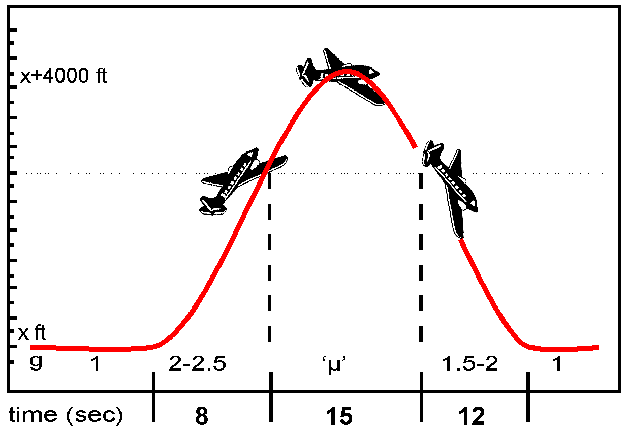
Cessna Parabolic Aircraft
To complement the various facilities described above it is also possible to perform real microgravity conditions provided by a small research aircraft.
Parabolic Flights with the Cessna
Citation-II - A typical duration of a parabolic flight is about 1 to 4 hours,
according to the user requirements. The home base for the aircraft is Schiphol
Airport in Amsterdam, although takeoff and landing could be made from different
paces within Europe depending on the user location and experiment requirements.
To create the microgravity environment, the aircraft follows a trajectory as
in the Figure 1, from steady normal horizontal flight, the aircraft pulls up
for about 8 sec. The aircraft engines thrust is then strongly reduced to set-in
the parabolic free fall. During the free fall period the engines thrust is adjusted
to compensate the effect of the air drag making use of the micro gravity flight
director (see Figure 3) designed by the Delft University of Technology. The
micro gravity flight director also gives the pilot the required elevator angle
in order to maintain the normal acceleration within +/- 0.01 g. After about
15 sec. of micro gravity the aircraft pulls up at about 1.5 to 2.0 g for approximately
12 sec., diving at 50 degrees (pullout) to come back to steady horizontal flight.
These maneuvers are flown separated by intervals of minimum 2 minute. Longer
intervals between parabolas are possible, giving enough time to change experimental
setup, as requested by experimenters prior to the flight.
The number of parabolas flown per flight hour is between 12 and 15, depending
on the interval time between parabolas. With the use of the special flight director
it is also possible to fly intermediate g-levels ranging form microgravity to
1×g.
 |
Figure 2: Cessna /
Citation-II during parabolic flight maneuver.
Figure 3: Flight deck with the
microgravity flight director.

Figure 4: Aircraft cabin / cockpit
layout. Cabin length is 6.4 meter.
Figure 5: Setup for tele-science and tele-operations for parabolic flight experiment.
When necessary additional experiment control and monitoring may be provided during the flight through tele-science and tele-operations.
Cessna Citation Detailed description
|
When you are interested to perform a (collaborative) series of (pilot) studies using the parabolic aircraft you are invited to contact us to discuss various possibilities before sending an experiment proposal. You may also directly send an experiment proposal either to DESC or respond to one of the international 'Announcements of Opportunities' (AO) as are in general annually issued by the European Space Agency (ESA) or other space agencies. You may also apply via an unsolicited proposal to ESA via the 'fast track' Continuously Open Research Announcements. You may contact us when you need any support for this. Dutch scientists may also apply nationally via a NWO-NSO proposal. An additional copy of the proposal has to be provided to DESC for technical and operational evaluations.
See for the latest developements related to this parabolic aircraft and its flight control system a paper by Kraeger A.M. (Alwin), van Paassen M.M. (René). Micro- and partial gravity atmospheric flight. Congres of the American Institute for Aeronautics and Astronautics (AIAA) in Monterey, 2002. Download full pdf version (1.9 Mb).
The Cessna-Citation-II is a national research aircraft operated by the Delft University of Technology, Dept. of Aerospace engineering, Control and Simulation Division (TUDelft/CS), also visit this site to download 2 page brochure), and the National Aerospace Laboratory (NLR).